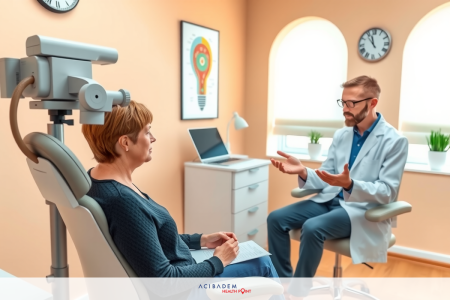Keratoconus Eye Pain Relief: Effective Strategies
Keratoconus Eye Pain Relief: Effective Strategies Keratoconus makes the cornea thin and cone-shaped. This causes blurry vision and eye pain. It changes daily life a lot. It’s important to find ways to ease the pain and improve life with keratoconus relief methods.
This guide will show you how to handle managing keratoconus symptoms. It covers old and new ways to help. With the right treatment and care, people can feel better and see clearer.
Understanding Keratoconus: Causes and Symptoms
Keratoconus makes the cornea thin and bulge, looking like a cone. This changes how we see things. We will look at what causes it and how to spot the signs.
What Causes Keratoconus?
Many things can cause keratoconus, like genes and the environment. Some people might be more likely to get it because of their genes. Rubbing your eyes a lot and being in the sun too much can make it worse.
Conditions like asthma, Down syndrome, and hay fever might also play a part.
Recognizing the Symptoms of Keratoconus
The signs of keratoconus can be mild or severe. They start with blurry vision and feeling sensitive to light. Later, you might see double, see ghost images, need glasses more often, and feel eye strain.
Spotting these signs early is key to getting help and treatment.
Importance of Early Diagnosis
Finding keratoconus early is key to managing this eye disease. Spotting the signs early and getting medical help can really help. It can also slow down the disease from getting worse.
How is Keratoconus Diagnosed?
Doctors use several ways to find keratoconus. One main way is corneal topography. This makes a detailed map of the cornea. It helps doctors see if there are any signs of keratoconus.
Visual acuity tests also help. They check how clear your vision is. This can show if your vision is getting worse because of the disease.
Why Early Detection Matters
Finding keratoconus early is very important. It means you can get the right treatment faster. This can be things like special contact lenses or corneal cross-linking. These treatments can stop the cornea from getting worse.
Knowing how important it is to find keratoconus early helps people get regular eye checks. This means getting help early and having better outcomes in the long run.
Keratoconus Eye Pain Relief Techniques
For people with keratoconus, finding ways to ease the pain is key. Wearing protective eyewear is a top tip. It keeps eyes safe from UV rays and dust, helping with the pain.
Changing your environment can also help. Make sure your home and work are moist to avoid dry eyes. Also, set up your computer screens right and use anti-glare screens to ease eye strain.
Regular eye lubrication is vital for less pain. Use eye drops as your doctor says to keep your eyes moist. This helps with the dryness that keratoconus can cause.
Take breaks when you’re doing things that make you stare a lot, like reading or on a computer. Following the 20-20-20 rule helps too. This means looking away for 20 seconds every 20 minutes at something 20 feet away.
| Technique | Description | Benefits |
|---|---|---|
| Protective Eyewear | Use of glasses or lenses to shield eyes from UV rays and environmental irritants. | Reduces exposure, prevents irritation. |
| Environmental Adjustments | Maintaining humidity, positioning screens properly, reducing glare. | Minimizes dry eyes and eye strain. |
| Eye Lubrication | Using prescribed eye drops regularly. | Prevents dryness, relieves discomfort. |
| Taking Breaks | Frequent breaks during activities requiring visual focus. | Allows eyes to rest, reduces strain and pain. |
Keratoconus Eye Pain Relief: Effective Strategies Managing keratoconus pain means using a mix of these tips that fit you best. Talking to an eye expert helps find the right ways to ease the pain.
Keratoconus Treatment Options
Looking into keratoconus treatment options is key for managing this eye issue. There are new ways like corneal cross-linking and old ones like corneal transplants. Also, special contact lenses help a lot with keratoconus.
Cross-linking Procedure
Corneal cross-linking is a simple surgery to make the cornea stronger. It uses special drops and light to make the cornea’s fibers bond better. This stops keratoconus from getting worse and might prevent a corneal transplant. It works best in the early stages.
Corneal Transplants
If keratoconus gets really bad, a corneal transplant might be needed. There are two main types:
- Penetrating Keratoplasty (PK): This is when the whole cornea is replaced.
- Deep Anterior Lamellar Keratoplasty (DALK): This is when only the bad parts of the cornea are replaced.
Keratoconus Eye Pain Relief: Effective Strategies These surgeries can make vision better and make the cornea healthier. They give hope to people with severe keratoconus.
Contact Lenses for Keratoconus
Contact lenses are a good choice for keratoconus. There are special lenses that make seeing better and feel more comfortable:
- Rigid Gas Permeable (RGP) Lenses: These lenses have a smooth surface. They help make vision clear by fixing the cornea’s shape.
- Hybrid Lenses: These lenses mix a hard center with soft edges. They give clear vision like RGP lenses but are more comfortable.
- Scleral Lenses: These big lenses sit on the sclera over the cornea. They give great vision and comfort for severe keratoconus.
Each contact lens type has its own benefits. The best one depends on what the patient needs.
The table below shows these treatment options. It lists their main points and good things about them:
| Treatment | Purpose | Benefits | Suitability |
|---|---|---|---|
| Corneal Cross-linking | Strengthen cornea | Halts progression, minimally invasive | Early to moderate keratoconus |
| Corneal Transplants | Replace damaged cornea | Restores vision, permanent solution | Advanced keratoconus |
| Contact Lenses | Improve vision | Enhanced comfort, customizable | All stages of keratoconus |
Using Contact Lenses for Pain Management
Contact lenses can help with the pain from keratoconus. They make your vision clearer and help with pain. We will look at different contact lenses and how to take care of them. Keratoconus Eye Pain Relief: Effective Strategies
Types of Lenses Available
There are many contact lenses for keratoconus pain:
- Soft Contact Lenses: These are comfy but might not give the clearest vision for very bad cases.
- Rigid Gas Permeable (RGP) Lenses: RGP lenses work better by staying in place on the curved cornea. They are key for managing keratoconus pain.
- Scleral Lenses: These big lenses cover the whole cornea. They help with pain and correct vision for severe keratoconus.
How to Properly Wear and Care for Them
Using and taking care of contact lenses right is key. Here are some tips:
- Clean Hands: Always wash and dry your hands well before touching contact lenses to stop infections.
- Use Recommended Solutions: Only use the cleaning and storage solutions your eye doctor says to use.
- Regular Cleaning: Clean your contact lenses every day to get rid of dirt and disinfect them. This helps with pain.
- Avoid Overwearing: Stick to the recommended wearing time to prevent eye strain and other problems.
Keratoconus Eye Pain Relief: Effective Strategies Choosing the right contact lenses and taking good care of them can make you much more comfortable. It also helps keep your eyes healthy.
| Type of Lens | Primary Benefit | Care Instructions |
|---|---|---|
| Soft Contact Lenses | Comfort | Daily cleaning; replace as per schedule |
| Rigid Gas Permeable (RGP) Lenses | Visual Acuity | Daily cleaning; use storage solution |
| Scleral Lenses | Comprehensive Pain Relief | Special cleaning; follow storage guidelines |
Medications for Managing Keratoconus Symptoms
Managing keratoconus symptoms often involves using medicines. These can help ease discomfort and tension. Eye drops and anti-inflammatory drugs are key options.
Eye drops help with dryness, irritation, and tired eyes. Lubricating drops keep the eyes moist. This reduces eye strain and makes you feel better.
Anti-inflammatory medications help fight inflammation that makes keratoconus worse. They come as eye drops or pills. Eye drops help right away without affecting the whole body. Pills help more but might have side effects. Keratoconus Eye Pain Relief: Effective Strategies
| Medication Type | Purpose | Common Brands |
|---|---|---|
| Lubricating Eye Drops | Moisturize ocular surface | Systane, Refresh |
| Topical Anti-inflammatories | Reduce inflammation in the eye | Prednisolone, Ketorolac |
| Systemic Anti-inflammatories | Alleviate overall inflammation | Ibuprofen, Prednisone |
New treatments are being made for keratoconus. Cross-linking medications help make the cornea stronger. This can slow down keratoconus.
Using different medicines, old and new, can make life better for people with keratoconus. Always talk to your eye doctor to find the best treatment for you.
Non-surgical Approaches to Keratoconus Pain Relief
Looking into non-invasive ways to help with keratoconus can make life better. These methods include eye exercises and eating right to support eye health.
Eye Exercises and Techniques
Adding eye exercises for keratoconus to your daily life can make your eyes stronger. This might lessen the pain. Here are some exercises you can do: Keratoconus Eye Pain Relief: Effective Strategies
- Palming: Warm your hands, then cover your closed eyes with them for a bit. It helps ease eye strain.
- Blinking: Blink slowly and on purpose to keep your eyes moist and flexible.
- Focus Shifting: Switch your focus from something close to something far away. It helps your eyes adjust better.
Diet and Nutrition Tips
Eating right is key to helping with keratoconus without surgery. Eat foods full of nutrients good for your eyes, like:
| Food | Nutrient | Benefits |
|---|---|---|
| Carrots | Beta-carotene | Helps your eyes stay healthy and see better at night |
| Spinach | Lutein and Zeaxanthin | Keeps your eyes safe from damage when it’s bright |
| Salmon | Omega-3 Fatty Acids | Lowers inflammation and helps your retina work better |
| Almonds | Vitamin E | Stops damage from happening in your eyes |
Doing eye exercises for keratoconus and eating well can really help ease keratoconus symptoms. Keratoconus Eye Pain Relief: Effective Strategies
Alternative Therapies for Keratoconus Relief
Looking into other ways to help with keratoconus can make life easier. Things like acupuncture and herbal remedies might help. They could ease pain and keep eyes healthy.
Acupuncture and Herbal Remedies
Acupuncture uses tiny needles to help with eye pain. It comes from Traditional Chinese Medicine. People say it helps blood flow better and lessens swelling. This might make keratoconus symptoms feel better.
Herbal remedies are also used for keratoconus. Herbs like ginkgo biloba and bilberry help eye health. They boost blood flow and fight off harmful stuff in the body. But, we don’t have much proof they work. Always talk to a doctor before trying them.
Acupuncture and herbal remedies might help with keratoconus. But they should not replace regular medical care. Using them with other treatments might help more. This could make living with keratoconus better.
FAQ
What are some effective methods for keratoconus eye pain relief?
To ease keratoconus eye pain, use protective eyewear and adjust your environment. Try eye exercises and proper lens care too. Talk to eye care experts for personalized advice.
What causes keratoconus?
Keratoconus can come from genes, the environment, or both. It starts in teens and makes the cornea thin and change shape over time.
What are the symptoms of keratoconus?
Symptoms include blurry vision, eye sensitivity, and strain. If you notice these signs early, you can get help and manage it better.
How is keratoconus diagnosed?
Doctors use tests like corneal topography and visual acuity to diagnose keratoconus. These tests check the cornea's shape and health to choose the right treatment.
Why does early detection of keratoconus matter?
Finding keratoconus early helps manage symptoms better and may slow it down. Early treatment like corneal cross-linking can also strengthen the cornea.
What are some pain relief techniques for keratoconus?
For pain relief, use special contact lenses and eye drops as prescribed. Adjust your environment and eat well. These steps can ease discomfort and boost eye health.
What treatment options are available for keratoconus?
Treatments include corneal cross-linking, transplants, and special contact lenses. Each option helps with vision and symptom control at different disease stages.
What types of contact lenses are used for keratoconus treatment?
For keratoconus, you can use soft, rigid gas permeable, or scleral lenses. Each type fits the cornea's shape to improve vision and comfort.
How should I care for my contact lenses if I have keratoconus?
Clean your lenses regularly with the right solutions and follow your eye doctor's wear schedule. Good care prevents discomfort and infections.
What medications can help manage keratoconus symptoms?
Eye drops, anti-inflammatory drugs, and other medicines can ease keratoconus symptoms. They help reduce inflammation, pain, and increase comfort.
Are there non-surgical approaches to keratoconus pain relief?
Yes, try eye exercises, diet tips, and lifestyle changes. These methods can strengthen eye muscles and support eye health, easing symptoms.
Can alternative therapies help with keratoconus pain relief?
Some people find relief with acupuncture and herbal remedies for keratoconus. But, talk to an eye doctor before starting any new therapy.













